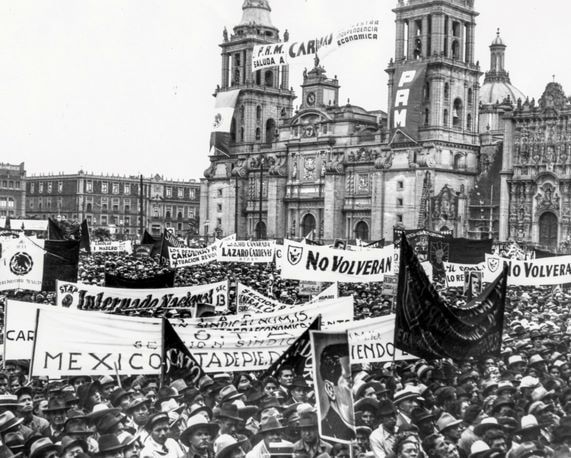The future of oil in Mexico is uncertain
The Oil Expropriation is the stellar moment in our history. In the last four years, a new basin was discovered in Mexico's geography.

Mexico faces a negative slope in the national production curve "and we have not been able to lift it, although this does not mean that oil will run out tomorrow or that there will be a sudden depletion, this will be gradual", affirms Fabio Barbosa Cano, specialist of the Economic Research Institute (IIEc).
The hydrocarbons expert with more than 100 publications on the subject, refers that the Mexican nation produces, on average, 1,600 million barrels per day. However, our large oil fields are decreasing their potential day by day. On the occasion of the 84th anniversary of the Oil Expropriation, commemorated on March 18, the university professor remarks that the future of hydrocarbons is uncertain.
However, the federal government defends what is left of these resources, which represent purchases in the regions where Petróleos Mexicanos (Pemex) operates, as well as an economic spill in the coast of the Gulf of Mexico, where most of the national oil installations are located.
Although extraction decreases, the State continues to receive funds even though, from an accounting point of view, the state-owned company is bankrupt; its assets are less than its liabilities, that is to say, its debts are greater than the sum of its assets and capital. Despite the deficit in the finances, the current government, like the previous ones, finances part of its current spending or its investments through oil.
Based on the last appearance of the director of Pemex, Octavio Romero Oropeza, in the Chamber of Deputies, from January to August 2021, the total income was 864 billion pesos. Of this total, "123 billion pesos were destined to operating expenses; 223 billion to the payment of gasoline, the resale merchandise. Of the surplus, -518 billion pesos-, 176 billion pesos were taken for investment expenses, so that a primary balance, before taxes, of 342 billion pesos is left".
And he adds: "After that, Pemex has to pay taxes and duties for 438 billion pesos, that is to say, pay the public treasury more than what it has in cash, and if we add to that that it has to pay 101 billion pesos in debt service, it is clear that the problem is the tax burden it still has".
In recent weeks, the conflict between Russia and Ukraine arose, and due to the fear of a future oil shortage, oil prices rose unusually high. However, some analysts point out that the increase in Pemex's income "is a mirage". If the crisis in Ukraine is prolonged and there is a drop in world supply, Mexico runs the risk of being affected in the operation of domestic industries that depend on natural gas imports, warns Barbosa Cano.
New options
Although the general trend of extraction is downward, in the last four years what could be a new oil basin in the Gulf of Mexico has been discovered.
It is located approximately 60 kilometers off the coast of Tabasco, not in the area known as Litoral Tabasco, but in the deep sea, further north. To date, Pemex, which began exploration, discovered three oil and gas producing wells there: Niquita-1, Chamak-1, and Saap-1. It is a zone in water depths of 400 to 700 meters, between the water mirror and the seabed.
Two other wells of the Italian National Hydrocarbon Corporation: Saásken-1 and Sayulita-1. Two more of the Spanish Repsol: Polok-1 and Chinwol-1; an equal number of consortiums where English and American companies are associated: Zama-1 and its delimiters, besides Cholula-1 of Murphy-South; also, the Yoti Oeste-1.
Because of the proximity, there could be agreements for common storage, processing, and transportation facilities on the surface. Of course, no one is talking about a new Cantarell, but it is a newly emerging development pole.

Mexican identity
On March 18, 1938, the then President of Mexico, Lázaro Cárdenas del Río, issued the Oil Expropriation Decree, which consisted of the legal appropriation of the hydrocarbons exploited by 17 foreign companies, which had control of the industry, to become the property of Mexicans.
The main reason for this embargo was the constant refusal of the companies to improve the salary and working conditions of the employees. It was established that the State would have total control over the production and commercialization of oil in national territory, which allowed the federal government to have additional economic resources to those coming from taxes, products, duties, or benefits.
Hours after the expropriation took place, the university community, particularly the School of Engineering, had extraordinary participation. At that time, the then rector, Luis Chico Goerne, went out to demonstrate together with the citizens and accompanied by members of UNAM schools, recalls Barbosa Cano.
"This historic event is part of the identity of Mexicans, a source of pride that defines us as members of this great country. We must not forget this feat, and emphasis has been placed on the great role played by the workers in this process," says the expert.
For Barbosa Cano, the Oil Expropriation continues as "a stellar moment in our history"; it was a juncture in which the organized majority, under the leadership of President Cárdenas del Río, successfully faced the harassment of the great international powers, secularly in the struggle for the natural resources of different countries.
Then the workers joined large industrial unions and peasant federations that were reconstituted, such as the Mexican Regional Workers Confederation, which came from a process of decomposition, the workers regrouped and strengthened. This was a component without which the country would not have emerged victorious from a challenge of such magnitude, says the university specialist.




